CUTE-1.7+APD
Non-EO
Quick facts
Overview
| Mission type | Non-EO |
| Launch date | 21 Feb 2006 |
| End of life date | 24 Oct 2009 |
CUTE-1.7+APD (Cubical Tokyo Tech Engineering Satellite-1.7)
CUTE-1.7+APD (Avalanche Photodiode) is a follow-on CubeSat project to CUTE-I (launch June 30, 2003, CUTE-I reports telemetry reception in April 2008) developed mainly by students of LSS (Laboratory for Space Systems) at the Tokyo Institute of Technology (TITech), Tokyo, Japan. Overall project goals call for: a) the demonstration of new design technologies, and b) sharing of experiment opportunities with other institutes. The CUTE-1.7+APD design depends on commercially finished products rather than only on commercial grade electric components. Specific mission goals are: 1) 2) 3) 4) 5) 6) 7) 8)
• Demonstration of PDA (Personal Digital Assistant) as an onboard computer
• Attitude control experiment using magnetic torquer
• Amateur radio service - digital repeater (digipeater). The spacecraft has the CubeSat designation CO-56 (OSCAR-56)
• Demonstration of APD (Avalanche Photodiode) sensor module - developed by the Tokyo Institute of Technology Kawai Laboratory
• Tether deployment experiment.

Spacecraft
The double-cube satellite configuration conforms to the CubeSat standard in size (10 cm x 10 cm x 20 cm). The spacecraft design makes use of the so-called “SatelliteCore” concept, containing a functionally integrated bus system (for re-use on other systems). The SatelliteCore provides electrical power (3.3 V, 5 V, and unregulated) and USB (Universal Serial Bus) connection functions. This new SatelliteCore container is based on the CubeSat standard. The new SatelliteCore concept is intended to optimize cost and time of repetitive chores. However, the combination of the SatelliteCore container plus a mission/instrument container requires at least a double cube implementation for a mission.
The OBC is a COTS (Commercial Off-The-Shelf) PDA (Hitachi PDA NPD-20JWL) of about 100 mm x 70 mm in size. The PDA operating system is Windows (CE.NET 4.1), the primary communication is via USB, making the system friendly to users. Two switchable PDAs are being employed to make up a redundant system (Figure 4). Spacecraft attitude control: see experiment description.
Note: The CUTE-1.7+APD project employs a number of COTS parts. In this approach commercial finished products were integrated wherever possible rather than only commercial grade electric parts.
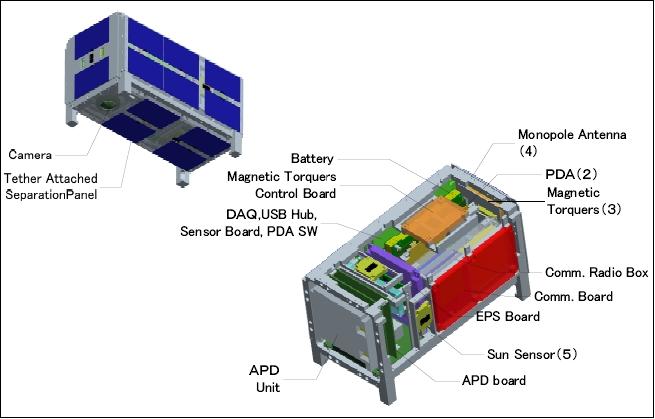
Spacecraft size | 10 cm x 10 cm x 20 cm |
Spacecraft mass | 3.6 kg (Cute-1.7 body with plumb) |
Spacecraft structure | Al 5052 body (with stainless iron for plumb), |
Spacecraft life | 2 weeks to 2 months (due to orbit perigee) |
ADCS | Attitude control: Magnet torquer |
C&DH (Command and Data Handling) | 2 PDA (redundancy system), 4Mbit SRAM |
EPS (Electric Power Subsystem) | GaAs silicon cells, (power generation of approx. 5W), |
RF communications | 144 MHz-band Rx (command uplink) |
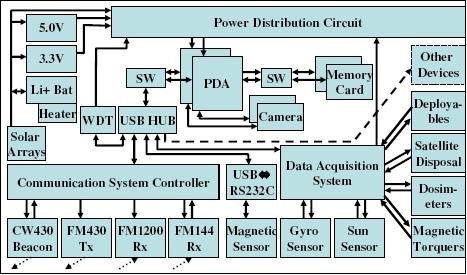
RF communications: Use of IARU (International Amateur Radio Union) standards and guidelines. CUTE-1.7+APD uses the FM packet transmission in downlink and uplink with the AX.25 protocol: a) a UHF (437.505 MHz) downlink, and b) the L-band (1268.500 MHz) in uplink. In addition, a CW (Continuous Wave) beacon in UHF (437.385 MHz) is being used. The sharing of the downlink with the amateur community increases the data acquisition capability of the spacecraft considerably.
CUTE-1.7+APD provides also the functionality of an on-orbit message box, open to the public, with an uplink in L-band (1200 MHz) and a downlink in UHF (430 MHz) band. The S&F (Store & Forward) capability of the CUTE-1.7+APD message box enables communication between radio operators who are not in the same footprint simultaneously. Messages received by the message box are stored and downlinked repeatedly for a certain duration (digital repeater function).

Launch
A launch of CUTE-1.7+APD took place on Feb. 21, 2006 (UTC) using the M-5 launch vehicle of JAXA as a sub-payload to the 3rd launch stage. The primary payload on this flight is the Astro-F (Akari) spacecraft of JAXA/ISAS (an astronomical S/C observing in the infrared region of the spectrum, all-sky survey with a telescope of 67 cm aperture) which uses a kick motor for its final orbit. The launch site was the Uchinoura Space Center (USC) at Uchinoura on Kagoshima Island, Japan.
Deployment/separation system: The separation system for CUTE-1.7+APD is a modified version of CSS (CUTE Separation System) as flown on CUTE-I. CUTE-1.7+APD was separated from the 3rd rocket stage, after the separation of the ASTRO-F spacecraft.
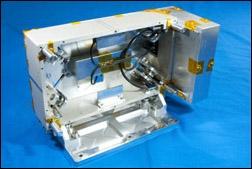
Note: A separate test flight of the modified CSS took place on July 10, 2005 as a secondary payload to the Astro-E2 (Suzaku) spacecraft of JAXA/ISAS (Japan Aerospace Exploration Agency/Institute of Space and Astronautical Science), Tokyo. This mission was referred to as: TSD (TITech Separation system Demonstration).
Orbit: nominal elliptical orbit of CUTE-1.7+APD, perigee = 185 km, apogee = 800 km, inclination = 98.4º. The atmospheric drag is relatively high near perigee altitudes so that CUTE-1.7+APD is expected to reenter Earth's atmosphere within a few weeks after launch.
Mission Status
• The reentry of the CUTE-1.7+APD nanosatellite took place on Oct. 24. 2009. 9)
• Since May 6, 2006, the CUTE-1.7+APD nanosatellite is transmitting again the CW signal with HK (House Keeping) data. However, the spacecraft does not respond to any commands. The spacecraft remains partially functioning in 2008 in this rather degraded condition.
Note: A launch of a second improved spacecraft, CUTE-1.7+ADP-2 as a secondary payload to the CartoSat-2A primary spacecraft of ISRO, took place on April 28, 2008. The launch site was SDSC (Satish Dhawan Space Centre), the SHAR launch range (Sriharikota, India) of ISRO.
• CUTE-1.7+APD stopped accepting any upload commands on the evening of March 16, 2006 when passing over Tokyo. Since then, the satellite is not under control anymore. The initial rescue operations confirmed that the command processing system stopped operation for some reason [the most probably cause is a SEL (Single Event Latchup)] - while normal operation of the command receiver was being verified. A possible explanation of this event is that a radiation damage might have caused the sudden death of the command processing controller. 10)
• After launch (Feb. 21, 2006), the nanosatellite separated correctly from the launch vehicle. Communications with CUTE-1.7+APD were established and the design methodology of the CUTE-1.7+APD spacecraft was validated. Telemetry reception reports from the amateur radio community were received from all over Japan. However, several technical problems did arise in the initial operations phase, resulting from recurrent IC failures in the communication subsystem to unfulfilled power consumption needs. These problems required all attention of the operations team for analysis. In this initial period, it was not possible to conduct the “attitude control experiment” and to verify its operation.
Experiment Complement
CUTE-1.7+APD is being used as a test bed for advanced magnetic torque control, having the capability of uploading control software.
Attitude control experiment
To demonstrate various attitude control algorithms, such as 3-axis stabilization, detumbling, and spin-up, with only magnetic torquers, CUTE-1.7+APD is furnished with 3 magnetic torquers in orthogonal configuration. These tiny devices with no moving parts have the potential for a most useful actuation on pico- or nanosatellites. Each torquer is a coil without iron core, 50 mm x 80 mm of size. The maximum magnetic moment is designed for 0.037 Am2.
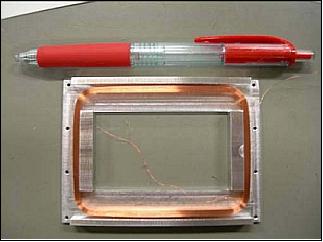
Size: length, side, thickness | 58.5 mm, 78.3 mm, 4 mm |
Mass | 15 gram |
Drive current | 10 mA |
Coil register | 540 Ω |
Electric power consumption | 46.3 mW |
Layer/Step | 25/40 |
Output magnetic torque | 1.1 x 10-6 Nm |
Magnetic dipole | 0.045 Am2 |
The satellite's ADCS (Attitude Determination and Control Subsystem) consists of a 3-axis gyro sensor, a 3-axis magnetometer (HMR2300 of Honeywell), a sun sensor and an Earth sensor. The gyro sensor is a combination of 3 ADXRS gyroscopes of Analog Devices. The Earth sensor is a CMOS camera of FlyCAM-CF with a fisheye lens and an image sensor of 1.3 Mpixel. Control algorithm: A B-dot based algorithm was chosen as the default algorithm loaded into the OBC.
APD (Avalanche Photodiode) detector experiment developed by the Kawai Laboratory of the Physics Department of TITech. The objective is to observe the low energy charged particle density distribution in LEO (Low Earth Orbit). APD is very small in size, exhibits a low-power consumption, and provides a high-speed response.
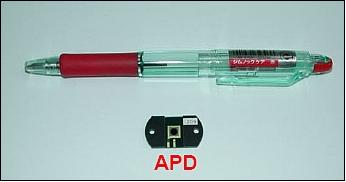

Satellite disposal system
At the end of its mission, a satellite deorbit system will be used. The tether system selected consists of a carbon nanotube electron emitter, an electrodynamic tether, a high-voltage power supply, and a tether end deployment mechanism.
The deployment mechanism realized uses a portion of the S/C bottom plate (as a second body) which separates from the body of Cute-1.7 on deployment. A camera mounted on the S/C is being used to monitor and verify the deployment procedure of the tether, ~ 30 m in length.
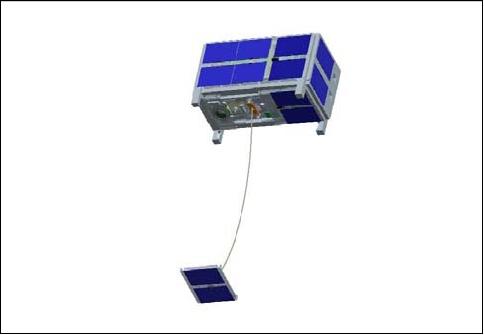
The deployment mechanism is shown in Figure 10 consisting of an inner plate and a separation plate of size 85 mm x 79 mm x 8 mm. The inner plate is the separation device unit mounted on the nanosatellite body while the separation plate (right side of Figure 10) is the unit to be released. Both plates are connected with a conductive tether stored inside the separation device. The tether deploys when the plate is being separated. The total mass of the deployment mechanism is about 100 g (separation plate mass is about 43 g).
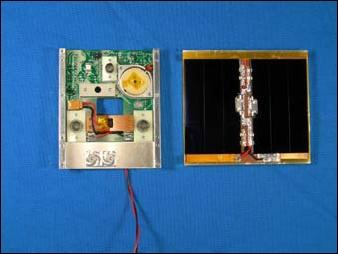

Figure 12 provides an illustration of the inner plate components such as the coiled stored tether, tether cover, tether deployment sensor, separation detector, pushing spring, and separation control electronics. A polyethylene type line named DyneemaTM made by Toyobo is used to tie the separation plate.
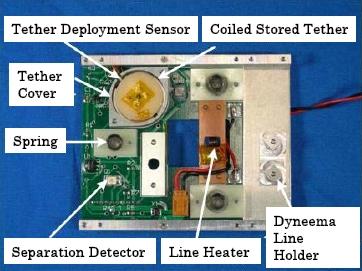
References
1) M. Iai, Y. Funaki, H. Yabe, K. Fujiwara, S. Masumoto, T. Usuda, S. Matunaga, J. Kataoka, T. Shima, “A PDA-Controlled Picosatellite, CUTE-1.7, and its Radiation Protection,” Proceedings of AIAA/USU Conference on Small Satellites, Logan, UT, Aug. 9-12, 2004, SSC-04-IX-8, URL (paper): http://lss.mes.titech.ac.jp/ssp/cute1.7/paper/wsane2005.pdf, URL (presentation): http://lss.mes.titech.ac.jp/ssp/cute1.7/paper/wsane2005_p.pdf
2) http://lss.mes.titech.ac.jp/ssp/cute1.7/index_e.html
3) K. Imai, N. Miyashita, M. Iai, K. Omagari, M. Asami, W. Miyazawa, H. Yabe, K. Miyamoto, T. Usuda, K. Fujiwara, S. Masumoto, S. Matunaga, “ Tokyo Tech Small Satellite Development Projects: CUTE-1.7 and TSUBAME,” Proceedings of WSANE 2005 (Workshop for Space, Aeronautical and Navigational Electronics 2005), KARI, Daejeon, Korea, March 3-5, 2005, pp. 131-136
4) N. Miyashita, M. Iai, K. Omagari, K. Imai, H. Yabe, K. Miyamoto, T. Iljic, T. Usuda, K. Fujiwara, S. Masumoto, Y. Konda, S. Sugita, T. Yamanaka, K. Konoue, S. Matunaga, “Development of Nano-Satellite Cute-1.7+APD and Its Current Status,” Proceedings of the 56th IAC 2005, Fukuoda, Japan, Oct. 17-21, 2005, IAC-05-B5.6.B.06, URL (paper): http://lss.mes.titech.ac.jp/ssp/cute1.7/paper/iac2005.pdf, URL (presentation): http://lss.mes.titech.ac.jp/ssp/cute1.7/paper/iac2005_p.pdf
5) N. Miyashita, M. Iai, K. Omagari, K. Imai, H. Yabe, K. Miyamoto, T. Iljic, T. Usuda, K.Fujiwara, S. Masumoto, Y. Konda, S. Sugita, T. Yamanaka, K. Konoue, H. Ashida , S. Matunaga, “Development and Flight Report of Pico-Satellite CUTE-1.7+APD,” Proceedings of 25th ISTS (International Symposium on Space Technology and Science) and 19th ISSFD (International Symposium on Space Flight Dynamics), Kanazawa, Japan, June 4-11, 2006, paper: 2006-f-08
6) S. Matunaga, T. Yamanaka, “Flight Model Development of Small Tether Deployment Mechanism For Nano-Satellite Cute-1.7 + APD,” Proceedings of the 57th IAC/IAF/IAA (International Astronautical Congress), Valencia, Spain, Oct. 2-6, 2006, IAC-06-C2.1.09
7) K. Fujiwara, K. Omagari, T. Iljic, S. Masumoto, Y. Konda, T. Yamanaka, Y. Tanaka, M. Maeno, T. Ueno, H.i Ashida, J. Nishida, T. Ikeda, S. Matunaga, ”Tokyo Tech Nano-Satellite Cute-1.7+APD Flight Operation Results and the Succeeding Satellite,” The 17th IFAC Symposium on Automatic Control in Aerospace, Toulouse, France, June 25-29, 2007, URL (paper): http://lss.mes.titech.ac.jp/ssp/cute1.7/paper/aca2007.pdf, URL (presentation): http://lss.mes.titech.ac.jp/ssp/cute1.7/paper/aca2007_p.pdf
8) M. Iai, Y. Funaki, H. Yabe, K. Fujiwara, S. Masumoto, T. Usuda, S. Matunaga, J. Kataoka, T. Shima, ”A PDA-Controlled Pico-Satellite, Cute-1.7, and its Radiation Protection,” Proceedings of the 18th AIAA/USU Conference on Small Satellites, Logan, UT, USA, August 12, 2004, SSC04-IX-8,, URL:http://lss.mes.titech.ac.jp/ssp/cute1.7/paper/SSC04-IX-8.pdf
9) http://lss.mes.titech.ac.jp/ssp/cute1.7/cute1.7-1/index_e.html
10) K. Omagari, K. Konoue, N. Miyashita, M. Iai, H. Yabe, K. Imai, K. Miyamoto, S. Masumoto, T. Iljic, K. Fujiwara, T. Usuda, Y. Konda, S. Sugita, T. Yamanaka, S. Matunaga, “Tokyo Tech Second Nano-Satellite Cute-1.7 + APD and its Flight Operation Results,” Proceedings of the 57th IAC/IAF/IAA (International Astronautical Congress), Valencia, Spain, Oct. 2-6, 2006, IAC-06-B5.3.02
The information compiled and edited in this article was provided by Herbert J. Kramer from his documentation of: ”Observation of the Earth and Its Environment: Survey of Missions and Sensors” (Springer Verlag) as well as many other sources after the publication of the 4th edition in 2002. - id="docs-internal-guid-af25b8b9-7fff-7187-3227-efb30bff7088">Comments and corrections to this article are always welcome for further updates (<eoportal@symbios.space).